Jing Jin
Performance Analysis of Cooperative Integrated Sensing and Communications for 6G Networks
May 14, 2025Abstract:In this work, we aim to effectively characterize the performance of cooperative integrated sensing and communication (ISAC) networks and to reveal how performance metrics relate to network parameters. To this end, we introduce a generalized stochastic geometry framework to model the cooperative ISAC networks, which approximates the spatial randomness of the network deployment. Based on this framework, we derive analytical expressions for key performance metrics in both communication and sensing domains, with a particular focus on communication coverage probability and radar information rate. The analytical expressions derived explicitly highlight how performance metrics depend on network parameters, thereby offering valuable insights into the deployment and design of cooperative ISAC networks. In the end, we validate the theoretical performance analysis through Monte Carlo simulation results. Our results demonstrate that increasing the number of cooperative base stations (BSs) significantly improves both metrics, while increasing the BS deployment density has a limited impact on communication coverage probability but substantially enhances the radar information rate. Additionally, increasing the number of transmit antennas is effective when the total number of transmit antennas is relatively small. The incremental performance gain reduces with the increase of the number of transmit antennas, suggesting that indiscriminately increasing antennas is not an efficient strategy to improve the performance of the system in cooperative ISAC networks.
Large Language Model Psychometrics: A Systematic Review of Evaluation, Validation, and Enhancement
May 13, 2025Abstract:The rapid advancement of large language models (LLMs) has outpaced traditional evaluation methodologies. It presents novel challenges, such as measuring human-like psychological constructs, navigating beyond static and task-specific benchmarks, and establishing human-centered evaluation. These challenges intersect with Psychometrics, the science of quantifying the intangible aspects of human psychology, such as personality, values, and intelligence. This survey introduces and synthesizes an emerging interdisciplinary field of LLM Psychometrics, which leverages psychometric instruments, theories, and principles to evaluate, understand, and enhance LLMs. We systematically explore the role of Psychometrics in shaping benchmarking principles, broadening evaluation scopes, refining methodologies, validating results, and advancing LLM capabilities. This paper integrates diverse perspectives to provide a structured framework for researchers across disciplines, enabling a more comprehensive understanding of this nascent field. Ultimately, we aim to provide actionable insights for developing future evaluation paradigms that align with human-level AI and promote the advancement of human-centered AI systems for societal benefit. A curated repository of LLM psychometric resources is available at https://github.com/valuebyte-ai/Awesome-LLM-Psychometrics.
Movable Antenna-Aided Cooperative ISAC Network with Time Synchronization error and Imperfect CSI
Jan 26, 2025Abstract:Cooperative-integrated sensing and communication (C-ISAC) networks have emerged as promising solutions for communication and target sensing. However, imperfect channel state information (CSI) estimation and time synchronization (TS) errors degrade performance, affecting communication and sensing accuracy. This paper addresses these challenges {by employing} {movable antennas} (MAs) to enhance C-ISAC robustness. We analyze the impact of CSI errors on achievable rates and introduce a hybrid Cramer-Rao lower bound (HCRLB) to evaluate the effect of TS errors on target localization accuracy. Based on these models, we derive the worst-case achievable rate and sensing precision under such errors. We optimize cooperative beamforming, {base station (BS)} selection factor and MA position to minimize power consumption while ensuring accuracy. {We then propose a} constrained deep reinforcement learning (C-DRL) approach to solve this non-convex optimization problem, using a modified deep deterministic policy gradient (DDPG) algorithm with a Wolpertinger architecture for efficient training under complex constraints. {Simulation results show that the proposed method significantly improves system robustness against CSI and TS errors, where robustness mean reliable data transmission under poor channel conditions.} These findings demonstrate the potential of MA technology to reduce power consumption in imperfect CSI and TS environments.
LLMs are Biased Evaluators But Not Biased for Retrieval Augmented Generation
Oct 28, 2024Abstract:Recent studies have demonstrated that large language models (LLMs) exhibit significant biases in evaluation tasks, particularly in preferentially rating and favoring self-generated content. However, the extent to which this bias manifests in fact-oriented tasks, especially within retrieval-augmented generation (RAG) frameworks-where keyword extraction and factual accuracy take precedence over stylistic elements-remains unclear. Our study addresses this knowledge gap by simulating two critical phases of the RAG framework. In the first phase, we access the suitability of human-authored versus model-generated passages, emulating the pointwise reranking process. The second phase involves conducting pairwise reading comprehension tests to simulate the generation process. Contrary to previous findings indicating a self-preference in rating tasks, our results reveal no significant self-preference effect in RAG frameworks. Instead, we observe that factual accuracy significantly influences LLMs' output, even in the absence of prior knowledge. Our research contributes to the ongoing discourse on LLM biases and their implications for RAG-based system, offering insights that may inform the development of more robust and unbiased LLM systems.
DIVESPOT: Depth Integrated Volume Estimation of Pile of Things Based on Point Cloud
Jul 07, 2024Abstract:Non-contact volume estimation of pile-type objects has considerable potential in industrial scenarios, including grain, coal, mining, and stone materials. However, using existing method for these scenarios is challenged by unstable measurement poses, significant light interference, the difficulty of training data collection, and the computational burden brought by large piles. To address the above issues, we propose the Depth Integrated Volume EStimation of Pile Of Things (DIVESPOT) based on point cloud technology in this study. For the challenges of unstable measurement poses, the point cloud pose correction and filtering algorithm is designed based on the Random Sample Consensus (RANSAC) and the Hierarchical Density-Based Spatial Clustering of Applications with Noise (HDBSCAN). To cope with light interference and to avoid the relying on training data, the height-distribution-based ground feature extraction algorithm is proposed to achieve RGB-independent. To reduce the computational burden, the storage space optimizing strategy is developed, such that accurate estimation can be acquired by using compressed voxels. Experimental results demonstrate that the DIVESPOT method enables non-data-driven, RGB-independent segmentation of pile point clouds, maintaining a volume calculation relative error within 2%. Even with 90% compression of the voxel mesh, the average error of the results can be under 3%.
A Label-Free and Non-Monotonic Metric for Evaluating Denoising in Event Cameras
Jun 13, 2024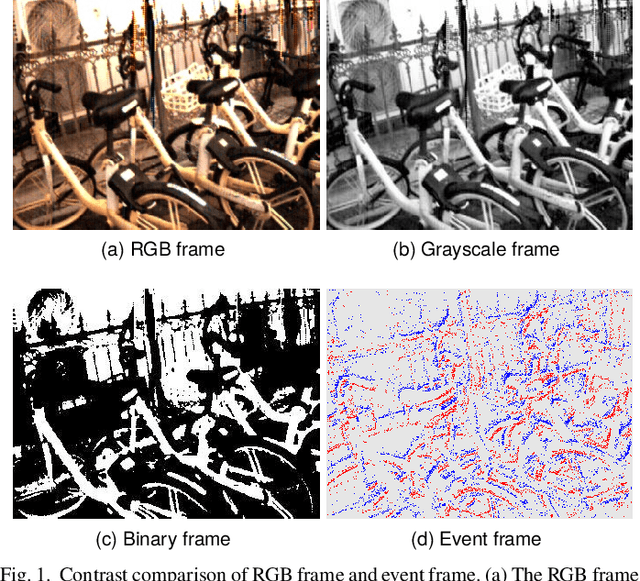
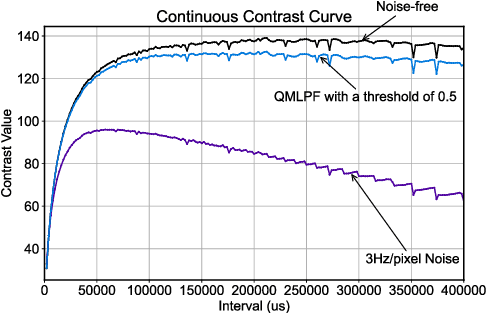

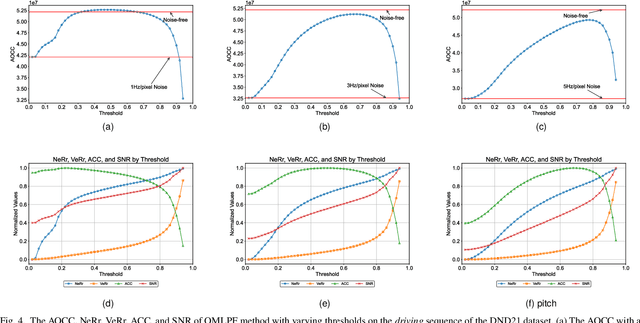
Abstract:Event cameras are renowned for their high efficiency due to outputting a sparse, asynchronous stream of events. However, they are plagued by noisy events, especially in low light conditions. Denoising is an essential task for event cameras, but evaluating denoising performance is challenging. Label-dependent denoising metrics involve artificially adding noise to clean sequences, complicating evaluations. Moreover, the majority of these metrics are monotonic, which can inflate scores by removing substantial noise and valid events. To overcome these limitations, we propose the first label-free and non-monotonic evaluation metric, the area of the continuous contrast curve (AOCC), which utilizes the area enclosed by event frame contrast curves across different time intervals. This metric is inspired by how events capture the edge contours of scenes or objects with high temporal resolution. An effective denoising method removes noise without eliminating these edge-contour events, thus preserving the contrast of event frames. Consequently, contrast across various time ranges serves as a metric to assess denoising effectiveness. As the time interval lengthens, the curve will initially rise and then fall. The proposed metric is validated through both theoretical and experimental evidence.
Iterative Causal Segmentation: Filling the Gap between Market Segmentation and Marketing Strategy
May 23, 2024



Abstract:The field of causal Machine Learning (ML) has made significant strides in recent years. Notable breakthroughs include methods such as meta learners (arXiv:1706.03461v6) and heterogeneous doubly robust estimators (arXiv:2004.14497) introduced in the last five years. Despite these advancements, the field still faces challenges, particularly in managing tightly coupled systems where both the causal treatment variable and a confounding covariate must serve as key decision-making indicators. This scenario is common in applications of causal ML for marketing, such as marketing segmentation and incremental marketing uplift. In this work, we present our formally proven algorithm, iterative causal segmentation, to address this issue.
InstructPipe: Building Visual Programming Pipelines with Human Instructions
Dec 15, 2023



Abstract:Visual programming provides beginner-level programmers with a coding-free experience to build their customized pipelines. Existing systems require users to build a pipeline entirely from scratch, implying that novice users need to set up and link appropriate nodes all by themselves, starting from a blank workspace. We present InstructPipe, an AI assistant that enables users to start prototyping machine learning (ML) pipelines with text instructions. We designed two LLM modules and a code interpreter to execute our solution. LLM modules generate pseudocode of a target pipeline, and the interpreter renders a pipeline in the node-graph editor for further human-AI collaboration. Technical evaluations reveal that InstructPipe reduces user interactions by 81.1% compared to traditional methods. Our user study (N=16) showed that InstructPipe empowers novice users to streamline their workflow in creating desired ML pipelines, reduce their learning curve, and spark innovative ideas with open-ended commands.
Multistatic Integrated Sensing and Communication System in Cellular Networks
May 22, 2023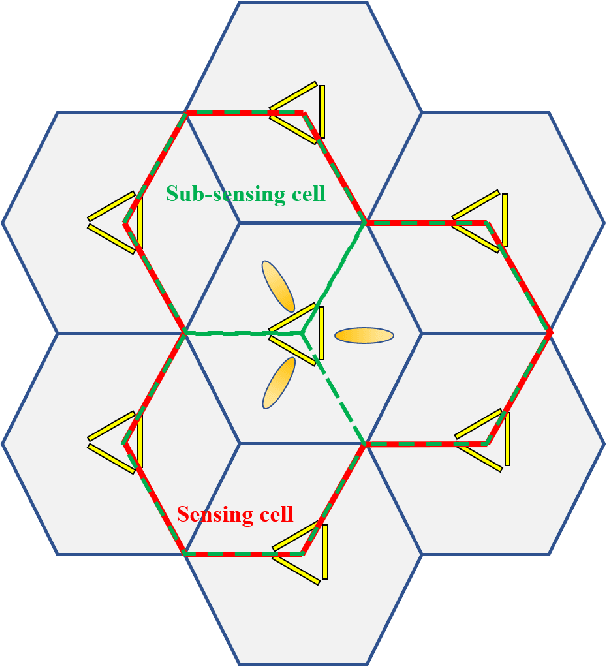
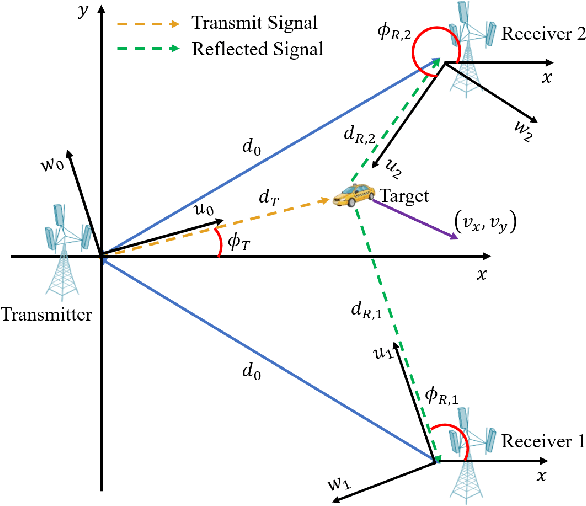

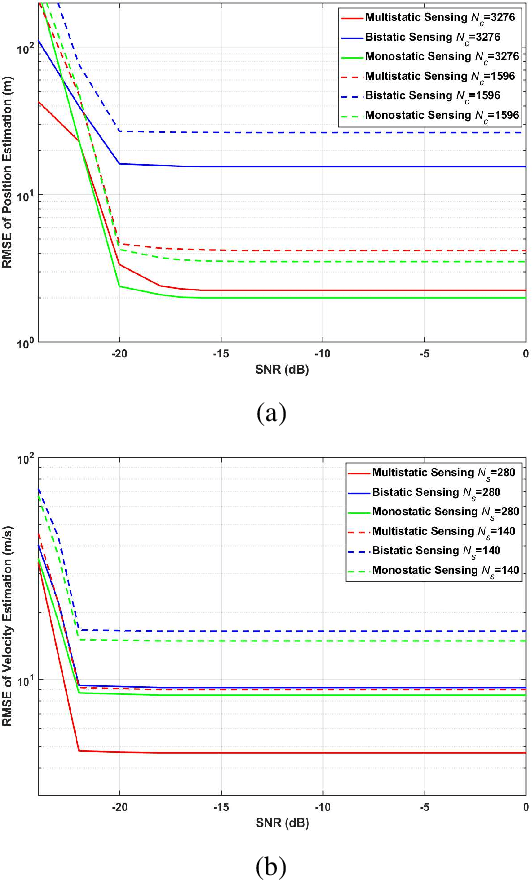
Abstract:A novel multistatic multiple-input multiple-output (MIMO) integrated sensing and communication (ISAC) system in cellular networks is proposed. It can make use of widespread base stations (BSs) to perform cooperative sensing in wide area. This system is important since the deployment of sensing function can be achieved based on the existing mobile communication networks at a low cost. In this system, orthogonal frequency division multiplexing (OFDM) signals transmitted from the central BS are received and processed by each of the neighboring BSs to estimate sensing object parameters. A joint data processing method is then introduced to derive the closed-form solution of objects position and velocity. Numerical simulation shows that the proposed multistatic system can improve the position and velocity estimation accuracy compared with monostatic and bistatic system, demonstrating the effectiveness and promise of implementing ISAC in the upcoming fifth generation advanced (5G-A) and sixth generation (6G) mobile networks.
IDO-VFI: Identifying Dynamics via Optical Flow Guidance for Video Frame Interpolation with Events
May 18, 2023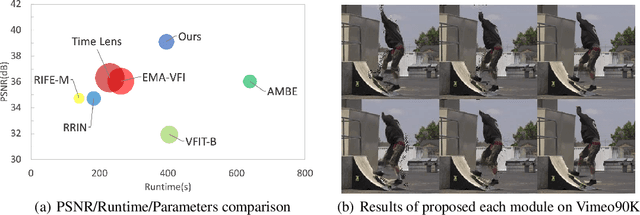
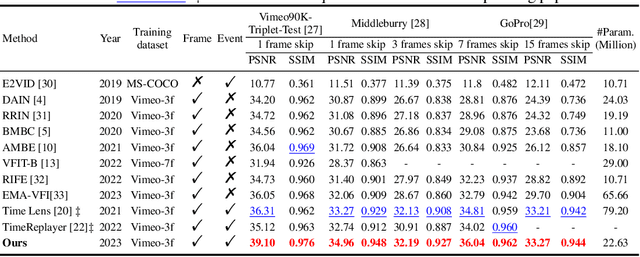
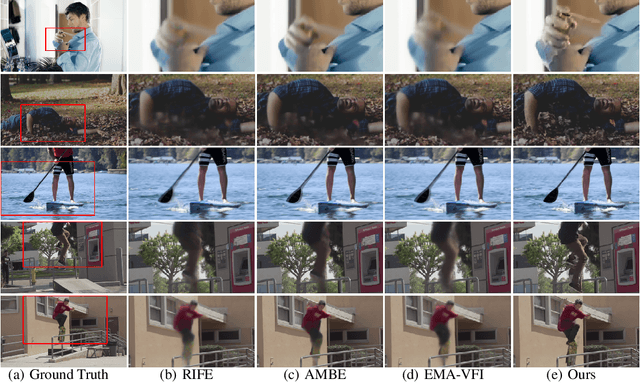
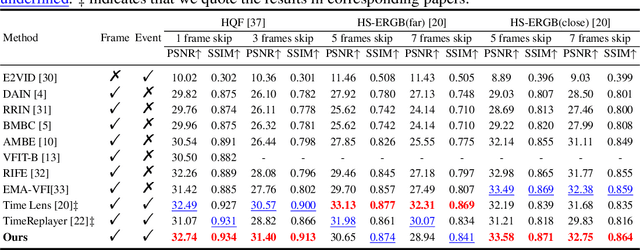
Abstract:Video frame interpolation aims to generate high-quality intermediate frames from boundary frames and increase frame rate. While existing linear, symmetric and nonlinear models are used to bridge the gap from the lack of inter-frame motion, they cannot reconstruct real motions. Event cameras, however, are ideal for capturing inter-frame dynamics with their extremely high temporal resolution. In this paper, we propose an event-and-frame-based video frame interpolation method named IDO-VFI that assigns varying amounts of computation for different sub-regions via optical flow guidance. The proposed method first estimates the optical flow based on frames and events, and then decides whether to further calculate the residual optical flow in those sub-regions via a Gumbel gating module according to the optical flow amplitude. Intermediate frames are eventually generated through a concise Transformer-based fusion network. Our proposed method maintains high-quality performance while reducing computation time and computational effort by 10% and 17% respectively on Vimeo90K datasets, compared with a unified process on the whole region. Moreover, our method outperforms state-of-the-art frame-only and frames-plus-events methods on multiple video frame interpolation benchmarks. Codes and models are available at https://github.com/shicy17/IDO-VFI.
 Add to Chrome
Add to Chrome Add to Firefox
Add to Firefox Add to Edge
Add to Edge